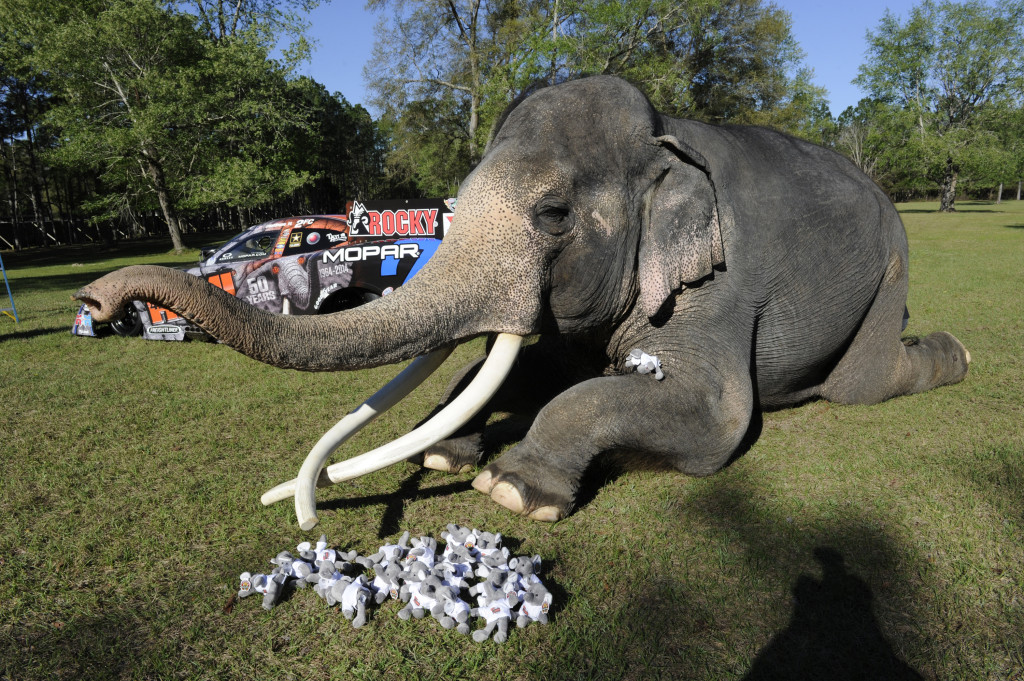
Strength, power and size. Those qualities have made the 426 HEMI racing engine a dominant force and earned it the nickname “The Elephant.”
That helps explain why Mopar is hanging out with elephants as it spends the year celebrating the 50th anniversary of this legendary powerplant.
The impact that the 426 HEMI would have on racing became apparent as soon as it hit the track in Daytona Beach, Fla., in 1964. That’s where an up-and-coming stock car driver named Richard Petty used the brand-new racing V-8 to dominate the field and win the Daytona 500 with a lead of more than one lap. In fact, the top three finishers in that race used HEMI power.
Not long after that, the 426 HEMI made its presence known at drag racing strips around the country. And it’s worth noting that many of today’s NHRA drag racing engines still use many of the same basic design features. It’s why the NHRA plays a large role in Mopar’s celebration this year, including a special paint scheme for Funny Car driver Matt Hagan’s Dodge Charger R/T at the Mopar Mile High Nationals in Colorado in July.

Pro Stock drivers Jeg Coughlin Jr. and Allen Johnson with the new Dodge Dart.
No one’s quite sure who tagged the 426 HEMI as “The Elephant.” But one look at the engine helps explain why the nickname stuck.
- Size: The 426 HEMI is a big engine, with 426 cubic inches (7.0 liters) of cylinder displacement. To handle all the power it produced, the racing 426 HEMI engine block was built with thicker walls. It also has a block deck height — the distance between the centerline of the camshaft and the top of the engine block — of 10.72 inches. And the bore spacing — the distance between the centerline of one cylinder bore and the next cylinder bore — of 4.80 inches. These dimensions easily made the 426 HEMI the biggest engine in racing at the time. It also meant the engine wouldn’t fit into smaller vehicles.
- Weight: The 426 HEMI is heavy. We’re talking between 650 and 700 pounds.
- Power: The 426 HEMI engines that shocked the world at the 1964 Daytona 500 were delivering somewhere in the neighborhood of 750 horsepower (racers never give away the exact number). The “street” version of the 426 HEMI (sold from 1965 to 1971) was marketed with a gross output of 425 hp and a net output of 350 hp in 1971. The nitromethane-fueled HEMI in Matt Hagan’s NHRA Funny Car makes in the neighborhood of 8,000 hp! The NHRA Pro Stock cars driven by Allen Johnson and Jeg Coughlin Jr. are making somewhere around 1,500 hp with their HEMI engines.
That’s some big horsepower. So when it was time to unveil the new Dodge Dart Pro Stock body and the Funny Car paint scheme, Mopar saw a chance to honor its racing heritage and contribute to the welfare of the 426 HEMI’s majestic namesake.
The place to go is Two Tails Ranch near Gainesville, Fla., site of this weekend’s NHRA Gatornationals.
For 30 years, Two Tails Ranch has been a haven for elephants and other animals. Owner and care-taker Patricia Zerbini is dedicated to the care and management of elephants needing temporary or permanent housing. She shares her more than 30 years of experience and knowledge via educational programs to teach others about these amazing animals.

Luke, one of the elephants at Two Tails Ranch in Florida.
Currently, four Asian elephants call Two Tails Ranch home, including Luke, who got a starring role with Mopar President and CEO Pietro Gorlier and the Mopar NHRA drivers during a recent photo shoot.
More than 250 elephants have passed through the gates of Two Tails Ranch since it opened. Some stayed temporarily while their home exhibits were being remodeled or built. Others stayed for retirement, medical needs, behavior problems or even in emergencies after hurricanes destroyed their zoos.
It is with pleasure that Mopar contributes toward the care, education and conservation efforts of elephants and we urge our enthusiastic owners and fans to consider doing the same.
And look for “The Elephant” to be a regular visitor to the NHRA victory lane this year.




